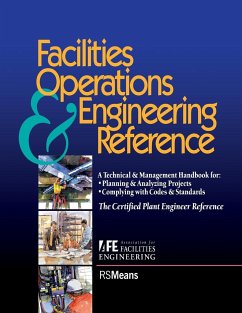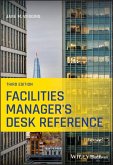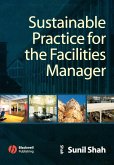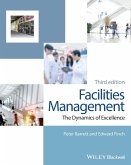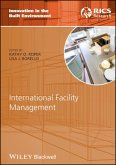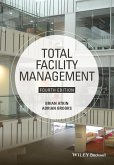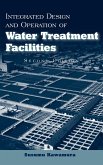Association for Facilities Engineering
Facilities Operations and Engineering Reference
Thecertified Plant Engineer Reference
Association for Facilities Engineering
Facilities Operations and Engineering Reference
Thecertified Plant Engineer Reference
- Broschiertes Buch
- Merkliste
- Auf die Merkliste
- Bewerten Bewerten
- Teilen
- Produkt teilen
- Produkterinnerung
- Produkterinnerung
Published collaboratively with the Association of Facilities Engineers, this book is based on the five certification manuals produced by AFE. Technical issues covered include Engineering Economy, Environmental Engineering, Safety and Maintenance, Civil Engineering, Electrical Engineering and Mechanical Engineering. It also contains numerous tables, charts and guidance related to industry standards.
Andere Kunden interessierten sich auch für
![Facilities Manager's Desk Reference Facilities Manager's Desk Reference]() Jane M. WigginsFacilities Manager's Desk Reference58,99 €
Jane M. WigginsFacilities Manager's Desk Reference58,99 €![Sustainable Practice for the Facilities Manager Sustainable Practice for the Facilities Manager]() Sunil ShahSustainable Practice for the Facilities Manager79,99 €
Sunil ShahSustainable Practice for the Facilities Manager79,99 €![Facilities Management Facilities Management]() Peter BarrettFacilities Management74,99 €
Peter BarrettFacilities Management74,99 €![Facilities Change Management Facilities Change Management]() Facilities Change Management70,99 €
Facilities Change Management70,99 €![International Facility Management International Facility Management]() International Facility Management109,99 €
International Facility Management109,99 €![Total Facility Management Total Facility Management]() Brian AtkinTotal Facility Management74,99 €
Brian AtkinTotal Facility Management74,99 €![Integrated Design and Operation of Water Treatment Facilities Integrated Design and Operation of Water Treatment Facilities]() Susumu KawamuraIntegrated Design and Operation of Water Treatment Facilities199,99 €
Susumu KawamuraIntegrated Design and Operation of Water Treatment Facilities199,99 €-
-
-
Published collaboratively with the Association of Facilities Engineers, this book is based on the five certification manuals produced by AFE. Technical issues covered include Engineering Economy, Environmental Engineering, Safety and Maintenance, Civil Engineering, Electrical Engineering and Mechanical Engineering. It also contains numerous tables, charts and guidance related to industry standards.
Produktdetails
- Produktdetails
- Verlag: Wiley
- Seitenzahl: 752
- Erscheinungstermin: 26. Januar 1999
- Englisch
- Abmessung: 280mm x 216mm x 40mm
- Gewicht: 1856g
- ISBN-13: 9780876294628
- ISBN-10: 087629462X
- Artikelnr.: 21878925
- Herstellerkennzeichnung
- Libri GmbH
- Europaallee 1
- 36244 Bad Hersfeld
- gpsr@libri.de
- Verlag: Wiley
- Seitenzahl: 752
- Erscheinungstermin: 26. Januar 1999
- Englisch
- Abmessung: 280mm x 216mm x 40mm
- Gewicht: 1856g
- ISBN-13: 9780876294628
- ISBN-10: 087629462X
- Artikelnr.: 21878925
- Herstellerkennzeichnung
- Libri GmbH
- Europaallee 1
- 36244 Bad Hersfeld
- gpsr@libri.de
AFE's mission is to provide education, certification, technical information and other relevant resources to plant and facility engineering, operation and maintenance professionals worldwide.
Foreword.
Acknowledgments.
Introduction.
Contributors to This Publication.
Chapter 1 Management.
Management Skills.
Project Communications.
Written Communications.
Meetings.
Project Record Filing System.
Handling Change Order Communications.
On-Site Communication.
A Word About Advanced Communications Technology.
Team Building.
Assembling Contractors and Consultants for the Project Team.
Techniques for Team Decision-Making and Problem-Solving.
Post-Mortem Team Review.
Characteristics of Team Leaders.
Resource Publications.
For Additional Information.
Chapter 2 Engineering Economics.
Interest Rates.
Cash Flows.
Interest Rate and Time Periods.
Capital Asset Management and the Timing of Cash Flows.
Life Cycle Cost Analysis Output/Results.
Capitalized Cost.
Uniform Gradient.
Rate of Return Criterion.
Minimum Attractive Rate of Return (MARR) and Incremental Rate of Return.
Resource Publications.
Chapter 3 Civil Engineering & Construction Practices.
Surveying.
Site Planning.
Understanding the Site Plan.
Soil Mechanics and Foundation Engineering.
Design of Drainage Pipes.
Storm Water Runoff.
Strength of Materials.
Basic Structural Engineering Principles.
Substructures.
Structural Steel.
Concrete.
Paving.
Overview of the Construction Process.
The Critical Path Method of Scheduling.
Construction Contract Documents.
Resource Publications.
For Additional Information.
Chapter 4 Maintenance.
Maintenance Goals & Objectives.
Establishing the Services Maintenance Will Provide.
Maintenance Staffing Options.
Geographical Maintenance Organization Structures.
Growing Maintenance Organizations.
Organizational Charts.
Attitudes.
The Financial Impact of Maintenance.
Standard Cost Justification.
Training.
Work Order Systems.
Planning and Scheduling.
Maintenance Scheduling.
Inventory and Purchasing.
Preventive Maintenance.
Predictive Maintenance or Condition Monitoring.
Management Reporting and Analysis.
Conclusion.
Resource Publications.
Chapter 5 Energy Efficiencies.
Energy Costs.
U.S. Utility Deregulation Legislation.
Purchasing Energy: New Choices.
Energy Service Companies.
Energy and the Environment.
Analyzing Your Energy Profile.
HVAC Energy Management.
Monitoring Utility Use.
Thermal Energy Storage Systems.
Meeting the Demand for Power.
Building Envelope.
Purchasing for Energy Efficiency: Windows and Doors.
Lighting.
Water Usage.
Recent Regulations and Innovations.
Resource Publications.
For Additional Information.
Chapter 6 Heating, Ventilation & Air Conditioning.
HVAC Heating and Cooling Loads.
Psychrometrics.
Computer Programs and Available Software.
Fan Design Characteristics.
Ductwork Design Characteristics.
Recommended Duct Design Procedures.
Exhaust Ventilation System Design.
Refrigeration.
Refrigeration Condensing Systems.
Heat Recovery Systems.
Air Filtration-Types & Performance.
HVAC Equations.
Resource Publications.
Chapter 7 Mechanical Engineering.
Statics and Dynamics.
Fluid Mechanics.
Thermodynamics.
Additional Information.
Vacuum Pumps and Systems.
Understanding Air Compressor Ratings.
Hydraulics.
Frequently Used Formulas and Equivalents.
Resource Publications.
Chapter 8 Instrumentation & Controls.
Terminology.
HVAC Automatic Controls.
Control Applications.
Electromechanical Relays.
Resource Publications.
For Additional Information.
Chapter 9 Electrical Engineering.
Units and Formulas.
What is Power Factor?
Power Quality.
Wave Forms.
Resistance, Reactance, and Impedance in Series AC Circuits.
Motors.
Lighting.
Overcurrent Protection.
National Electrical Code.
Electric Costs.
Industrial Control.
Resource Publications.
For Additional Information.
Chapter 10 Environmental, Health & Safety.
Air Quality and Air Emissions.
Indoor Air Quality.
Wastewater.
Hazardous Waste.
Solid Waste.
Underground Storage Tanks.
Leaking Underground Storage Tanks.
CERCLA, SARA, RCRA.
Safety and Health Regulations.
Occupational Safety and Health Act of 1970 (OSHAct).
OSHA Hazard Communication Program.
OSHA Inspections.
ADA Overview.
Fire Safety and the National Fire Protection Association (NFPA).
Summary of Procedures for Meeting Code Requirements.
Resource Publications.
For Additional Information.
Appendix.
Additional Compound Interest Tables.
Loan Amortization Spreadsheets.
Maintenance and Repair Schedules and Cost Data.
Laws of Force and Motion.
Steam Tables with Nomenclature.
Index.
Acknowledgments.
Introduction.
Contributors to This Publication.
Chapter 1 Management.
Management Skills.
Project Communications.
Written Communications.
Meetings.
Project Record Filing System.
Handling Change Order Communications.
On-Site Communication.
A Word About Advanced Communications Technology.
Team Building.
Assembling Contractors and Consultants for the Project Team.
Techniques for Team Decision-Making and Problem-Solving.
Post-Mortem Team Review.
Characteristics of Team Leaders.
Resource Publications.
For Additional Information.
Chapter 2 Engineering Economics.
Interest Rates.
Cash Flows.
Interest Rate and Time Periods.
Capital Asset Management and the Timing of Cash Flows.
Life Cycle Cost Analysis Output/Results.
Capitalized Cost.
Uniform Gradient.
Rate of Return Criterion.
Minimum Attractive Rate of Return (MARR) and Incremental Rate of Return.
Resource Publications.
Chapter 3 Civil Engineering & Construction Practices.
Surveying.
Site Planning.
Understanding the Site Plan.
Soil Mechanics and Foundation Engineering.
Design of Drainage Pipes.
Storm Water Runoff.
Strength of Materials.
Basic Structural Engineering Principles.
Substructures.
Structural Steel.
Concrete.
Paving.
Overview of the Construction Process.
The Critical Path Method of Scheduling.
Construction Contract Documents.
Resource Publications.
For Additional Information.
Chapter 4 Maintenance.
Maintenance Goals & Objectives.
Establishing the Services Maintenance Will Provide.
Maintenance Staffing Options.
Geographical Maintenance Organization Structures.
Growing Maintenance Organizations.
Organizational Charts.
Attitudes.
The Financial Impact of Maintenance.
Standard Cost Justification.
Training.
Work Order Systems.
Planning and Scheduling.
Maintenance Scheduling.
Inventory and Purchasing.
Preventive Maintenance.
Predictive Maintenance or Condition Monitoring.
Management Reporting and Analysis.
Conclusion.
Resource Publications.
Chapter 5 Energy Efficiencies.
Energy Costs.
U.S. Utility Deregulation Legislation.
Purchasing Energy: New Choices.
Energy Service Companies.
Energy and the Environment.
Analyzing Your Energy Profile.
HVAC Energy Management.
Monitoring Utility Use.
Thermal Energy Storage Systems.
Meeting the Demand for Power.
Building Envelope.
Purchasing for Energy Efficiency: Windows and Doors.
Lighting.
Water Usage.
Recent Regulations and Innovations.
Resource Publications.
For Additional Information.
Chapter 6 Heating, Ventilation & Air Conditioning.
HVAC Heating and Cooling Loads.
Psychrometrics.
Computer Programs and Available Software.
Fan Design Characteristics.
Ductwork Design Characteristics.
Recommended Duct Design Procedures.
Exhaust Ventilation System Design.
Refrigeration.
Refrigeration Condensing Systems.
Heat Recovery Systems.
Air Filtration-Types & Performance.
HVAC Equations.
Resource Publications.
Chapter 7 Mechanical Engineering.
Statics and Dynamics.
Fluid Mechanics.
Thermodynamics.
Additional Information.
Vacuum Pumps and Systems.
Understanding Air Compressor Ratings.
Hydraulics.
Frequently Used Formulas and Equivalents.
Resource Publications.
Chapter 8 Instrumentation & Controls.
Terminology.
HVAC Automatic Controls.
Control Applications.
Electromechanical Relays.
Resource Publications.
For Additional Information.
Chapter 9 Electrical Engineering.
Units and Formulas.
What is Power Factor?
Power Quality.
Wave Forms.
Resistance, Reactance, and Impedance in Series AC Circuits.
Motors.
Lighting.
Overcurrent Protection.
National Electrical Code.
Electric Costs.
Industrial Control.
Resource Publications.
For Additional Information.
Chapter 10 Environmental, Health & Safety.
Air Quality and Air Emissions.
Indoor Air Quality.
Wastewater.
Hazardous Waste.
Solid Waste.
Underground Storage Tanks.
Leaking Underground Storage Tanks.
CERCLA, SARA, RCRA.
Safety and Health Regulations.
Occupational Safety and Health Act of 1970 (OSHAct).
OSHA Hazard Communication Program.
OSHA Inspections.
ADA Overview.
Fire Safety and the National Fire Protection Association (NFPA).
Summary of Procedures for Meeting Code Requirements.
Resource Publications.
For Additional Information.
Appendix.
Additional Compound Interest Tables.
Loan Amortization Spreadsheets.
Maintenance and Repair Schedules and Cost Data.
Laws of Force and Motion.
Steam Tables with Nomenclature.
Index.
Foreword.
Acknowledgments.
Introduction.
Contributors to This Publication.
Chapter 1 Management.
Management Skills.
Project Communications.
Written Communications.
Meetings.
Project Record Filing System.
Handling Change Order Communications.
On-Site Communication.
A Word About Advanced Communications Technology.
Team Building.
Assembling Contractors and Consultants for the Project Team.
Techniques for Team Decision-Making and Problem-Solving.
Post-Mortem Team Review.
Characteristics of Team Leaders.
Resource Publications.
For Additional Information.
Chapter 2 Engineering Economics.
Interest Rates.
Cash Flows.
Interest Rate and Time Periods.
Capital Asset Management and the Timing of Cash Flows.
Life Cycle Cost Analysis Output/Results.
Capitalized Cost.
Uniform Gradient.
Rate of Return Criterion.
Minimum Attractive Rate of Return (MARR) and Incremental Rate of Return.
Resource Publications.
Chapter 3 Civil Engineering & Construction Practices.
Surveying.
Site Planning.
Understanding the Site Plan.
Soil Mechanics and Foundation Engineering.
Design of Drainage Pipes.
Storm Water Runoff.
Strength of Materials.
Basic Structural Engineering Principles.
Substructures.
Structural Steel.
Concrete.
Paving.
Overview of the Construction Process.
The Critical Path Method of Scheduling.
Construction Contract Documents.
Resource Publications.
For Additional Information.
Chapter 4 Maintenance.
Maintenance Goals & Objectives.
Establishing the Services Maintenance Will Provide.
Maintenance Staffing Options.
Geographical Maintenance Organization Structures.
Growing Maintenance Organizations.
Organizational Charts.
Attitudes.
The Financial Impact of Maintenance.
Standard Cost Justification.
Training.
Work Order Systems.
Planning and Scheduling.
Maintenance Scheduling.
Inventory and Purchasing.
Preventive Maintenance.
Predictive Maintenance or Condition Monitoring.
Management Reporting and Analysis.
Conclusion.
Resource Publications.
Chapter 5 Energy Efficiencies.
Energy Costs.
U.S. Utility Deregulation Legislation.
Purchasing Energy: New Choices.
Energy Service Companies.
Energy and the Environment.
Analyzing Your Energy Profile.
HVAC Energy Management.
Monitoring Utility Use.
Thermal Energy Storage Systems.
Meeting the Demand for Power.
Building Envelope.
Purchasing for Energy Efficiency: Windows and Doors.
Lighting.
Water Usage.
Recent Regulations and Innovations.
Resource Publications.
For Additional Information.
Chapter 6 Heating, Ventilation & Air Conditioning.
HVAC Heating and Cooling Loads.
Psychrometrics.
Computer Programs and Available Software.
Fan Design Characteristics.
Ductwork Design Characteristics.
Recommended Duct Design Procedures.
Exhaust Ventilation System Design.
Refrigeration.
Refrigeration Condensing Systems.
Heat Recovery Systems.
Air Filtration-Types & Performance.
HVAC Equations.
Resource Publications.
Chapter 7 Mechanical Engineering.
Statics and Dynamics.
Fluid Mechanics.
Thermodynamics.
Additional Information.
Vacuum Pumps and Systems.
Understanding Air Compressor Ratings.
Hydraulics.
Frequently Used Formulas and Equivalents.
Resource Publications.
Chapter 8 Instrumentation & Controls.
Terminology.
HVAC Automatic Controls.
Control Applications.
Electromechanical Relays.
Resource Publications.
For Additional Information.
Chapter 9 Electrical Engineering.
Units and Formulas.
What is Power Factor?
Power Quality.
Wave Forms.
Resistance, Reactance, and Impedance in Series AC Circuits.
Motors.
Lighting.
Overcurrent Protection.
National Electrical Code.
Electric Costs.
Industrial Control.
Resource Publications.
For Additional Information.
Chapter 10 Environmental, Health & Safety.
Air Quality and Air Emissions.
Indoor Air Quality.
Wastewater.
Hazardous Waste.
Solid Waste.
Underground Storage Tanks.
Leaking Underground Storage Tanks.
CERCLA, SARA, RCRA.
Safety and Health Regulations.
Occupational Safety and Health Act of 1970 (OSHAct).
OSHA Hazard Communication Program.
OSHA Inspections.
ADA Overview.
Fire Safety and the National Fire Protection Association (NFPA).
Summary of Procedures for Meeting Code Requirements.
Resource Publications.
For Additional Information.
Appendix.
Additional Compound Interest Tables.
Loan Amortization Spreadsheets.
Maintenance and Repair Schedules and Cost Data.
Laws of Force and Motion.
Steam Tables with Nomenclature.
Index.
Acknowledgments.
Introduction.
Contributors to This Publication.
Chapter 1 Management.
Management Skills.
Project Communications.
Written Communications.
Meetings.
Project Record Filing System.
Handling Change Order Communications.
On-Site Communication.
A Word About Advanced Communications Technology.
Team Building.
Assembling Contractors and Consultants for the Project Team.
Techniques for Team Decision-Making and Problem-Solving.
Post-Mortem Team Review.
Characteristics of Team Leaders.
Resource Publications.
For Additional Information.
Chapter 2 Engineering Economics.
Interest Rates.
Cash Flows.
Interest Rate and Time Periods.
Capital Asset Management and the Timing of Cash Flows.
Life Cycle Cost Analysis Output/Results.
Capitalized Cost.
Uniform Gradient.
Rate of Return Criterion.
Minimum Attractive Rate of Return (MARR) and Incremental Rate of Return.
Resource Publications.
Chapter 3 Civil Engineering & Construction Practices.
Surveying.
Site Planning.
Understanding the Site Plan.
Soil Mechanics and Foundation Engineering.
Design of Drainage Pipes.
Storm Water Runoff.
Strength of Materials.
Basic Structural Engineering Principles.
Substructures.
Structural Steel.
Concrete.
Paving.
Overview of the Construction Process.
The Critical Path Method of Scheduling.
Construction Contract Documents.
Resource Publications.
For Additional Information.
Chapter 4 Maintenance.
Maintenance Goals & Objectives.
Establishing the Services Maintenance Will Provide.
Maintenance Staffing Options.
Geographical Maintenance Organization Structures.
Growing Maintenance Organizations.
Organizational Charts.
Attitudes.
The Financial Impact of Maintenance.
Standard Cost Justification.
Training.
Work Order Systems.
Planning and Scheduling.
Maintenance Scheduling.
Inventory and Purchasing.
Preventive Maintenance.
Predictive Maintenance or Condition Monitoring.
Management Reporting and Analysis.
Conclusion.
Resource Publications.
Chapter 5 Energy Efficiencies.
Energy Costs.
U.S. Utility Deregulation Legislation.
Purchasing Energy: New Choices.
Energy Service Companies.
Energy and the Environment.
Analyzing Your Energy Profile.
HVAC Energy Management.
Monitoring Utility Use.
Thermal Energy Storage Systems.
Meeting the Demand for Power.
Building Envelope.
Purchasing for Energy Efficiency: Windows and Doors.
Lighting.
Water Usage.
Recent Regulations and Innovations.
Resource Publications.
For Additional Information.
Chapter 6 Heating, Ventilation & Air Conditioning.
HVAC Heating and Cooling Loads.
Psychrometrics.
Computer Programs and Available Software.
Fan Design Characteristics.
Ductwork Design Characteristics.
Recommended Duct Design Procedures.
Exhaust Ventilation System Design.
Refrigeration.
Refrigeration Condensing Systems.
Heat Recovery Systems.
Air Filtration-Types & Performance.
HVAC Equations.
Resource Publications.
Chapter 7 Mechanical Engineering.
Statics and Dynamics.
Fluid Mechanics.
Thermodynamics.
Additional Information.
Vacuum Pumps and Systems.
Understanding Air Compressor Ratings.
Hydraulics.
Frequently Used Formulas and Equivalents.
Resource Publications.
Chapter 8 Instrumentation & Controls.
Terminology.
HVAC Automatic Controls.
Control Applications.
Electromechanical Relays.
Resource Publications.
For Additional Information.
Chapter 9 Electrical Engineering.
Units and Formulas.
What is Power Factor?
Power Quality.
Wave Forms.
Resistance, Reactance, and Impedance in Series AC Circuits.
Motors.
Lighting.
Overcurrent Protection.
National Electrical Code.
Electric Costs.
Industrial Control.
Resource Publications.
For Additional Information.
Chapter 10 Environmental, Health & Safety.
Air Quality and Air Emissions.
Indoor Air Quality.
Wastewater.
Hazardous Waste.
Solid Waste.
Underground Storage Tanks.
Leaking Underground Storage Tanks.
CERCLA, SARA, RCRA.
Safety and Health Regulations.
Occupational Safety and Health Act of 1970 (OSHAct).
OSHA Hazard Communication Program.
OSHA Inspections.
ADA Overview.
Fire Safety and the National Fire Protection Association (NFPA).
Summary of Procedures for Meeting Code Requirements.
Resource Publications.
For Additional Information.
Appendix.
Additional Compound Interest Tables.
Loan Amortization Spreadsheets.
Maintenance and Repair Schedules and Cost Data.
Laws of Force and Motion.
Steam Tables with Nomenclature.
Index.

